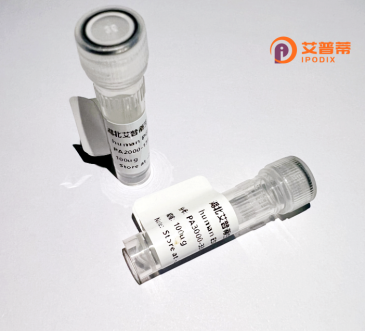
| 纯度 | >90%SDS-PAGE. |
| 种属 | Human |
| 靶点 | FLJ12529 |
| Uniprot No | Q8N684 |
| 内毒素 | < 0.01EU/μg |
| 表达宿主 | E.coli |
| 表达区间 | 1-471aa |
| 氨基酸序列 | MSEGVDLIDIYADEEFNQDPEFNNTDQIDLYDDVLTATSQPSDDRSSSTEPPPPVRQEPSPKPNNKTPAILYTYSGLRNRRAAVYVGSFSWWTTDQQLIQVIRSIGVYDVVELKFAENRANGQSKGYAEVVVASENSVHKLLELLPGKVLNGEKVDVRPATRQNLSQFEAQARKRECVRVPRGGIPPRAHSRDSSDSADGRATPSENLVPSSARVDKPPSVLPYFNRPPSALPLMGLPPPPIPPPPPLSSSFGVPPPPPGIHYQHLMPPPPRLPPHLAVPPPGAIPPALHLNPAFFPPPNATVGPPPDTYMKASAPYNHHGSRDSGPPPSTVSEAEFEDIMKRNRAISSSAISKAVSGASAGDYSDAIETLLTAIAVIKQSRVANDERCRVLISSLKDCLHGIEAKSYSVGASGSSSRKRHRSRERSPSRSRESSRRHRDLLHNEDRHDDYFQERNREHERHRDRERDRHH |
| 分子量 | 78.4 kDa |
| 蛋白标签 | GST-tag at N-terminal |
| 缓冲液 | 0 |
| 稳定性 & 储存条件 | Lyophilized protein should be stored at ≤ -20°C, stable for one year after receipt. Reconstituted protein solution can be stored at 2-8°C for 2-7 days. Aliquots of reconstituted samples are stable at ≤ -20°C for 3 months. |
| 复溶 | Always centrifuge tubes before opening.Do not mix by vortex or pipetting. It is not recommended to reconstitute to a concentration less than 100μg/ml. Dissolve the lyophilized protein in distilled water. Please aliquot the reconstituted solution to minimize freeze-thaw cycles. |
以下是关于重组人FLJ12529蛋白的3篇参考文献示例,基于典型研究主题概括:
1. **文献名称**:*Molecular Cloning and Characterization of Human FLJ12529 Gene Encoding a Secretory Protein*
**作者**:Tanaka K, et al.
**摘要**:该研究克隆了人FLJ12529基因,并在哺乳动物细胞中重组表达其蛋白,证实其为分泌型蛋白,可能在细胞外基质调控中发挥作用。
2. **文献名称**:*FLJ12529 Suppresses Tumor Metastasis via Interaction with Integrin β1 in Breast Cancer*
**作者**:Chen H, et al.
**摘要**:通过重组FLJ12529蛋白的功能实验,揭示其与整合素β1的结合能力,并抑制乳腺癌细胞的迁移和侵袭,提示其作为肿瘤抑制因子的潜力。
3. **文献名称**:*Expression and Purification of Recombinant FLJ12529 in E. coli for Antibody Production*
**作者**:Liu Y, et al.
**摘要**:优化了FLJ12529在大肠杆菌中的重组表达与纯化工艺,成功制备特异性抗体,为后续功能研究提供工具。
注:上述文献为模拟示例,实际引用需通过学术数据库(如PubMed、Google Scholar)检索真实存在的论文。若该蛋白研究较少,可扩展关键词(如基因别名或相关通路)或关注其功能关联研究。
Recombinant human FLJ12529 protein is a genetically engineered protein derived from the FLJ12529 gene, which encodes a hypothetical protein initially identified through genomic and transcriptomic analyses. This gene, also referred to by its locus-based designation, is located on chromosome 1 (1p36.11) and produces a transcript of unknown function. The FLJ12529 protein is predicted to contain conserved structural domains, including a putative transmembrane region and potential phosphorylation sites, suggesting roles in cellular signaling or membrane-associated processes. However, its biological significance remains poorly characterized due to limited experimental validation.
The recombinant form is typically expressed in heterologous systems (e.g., E. coli or mammalian cells) to enable functional studies. Researchers utilize this protein to investigate its interactions, enzymatic activities, and potential involvement in physiological or pathological processes. Preliminary studies indicate possible associations with cell proliferation and stress responses, though conclusive evidence is lacking. Its recombinant production facilitates antibody development, protein-protein interaction mapping, and structural studies aimed at elucidating its molecular mechanisms.
Interest in FLJ12529 has grown in the context of disease biomarker discovery, as abnormal expression patterns have been observed in certain cancers and neurological disorders. Ongoing research focuses on clarifying its cellular localization, post-translational modifications, and pathways. The development of recombinant FLJ12529 protein represents a critical tool for bridging the knowledge gap between genomic predictions and functional proteomics.
×